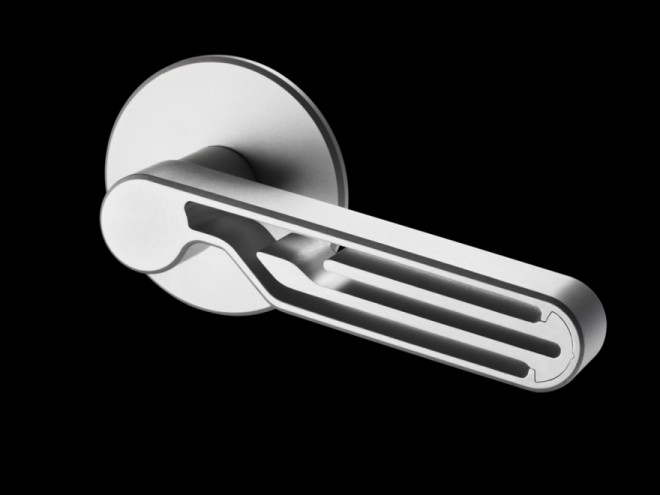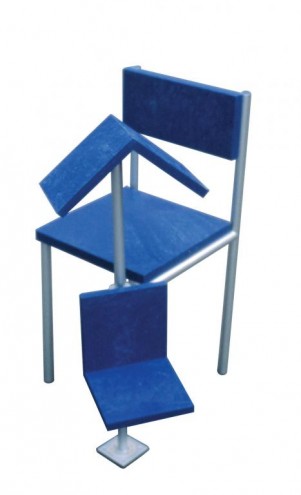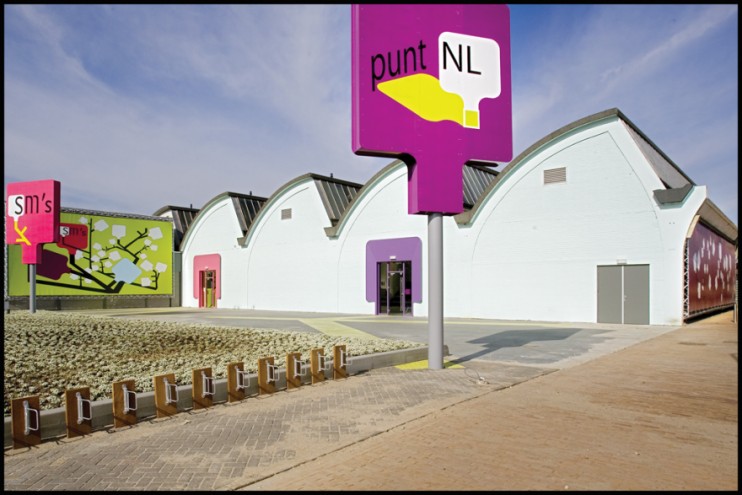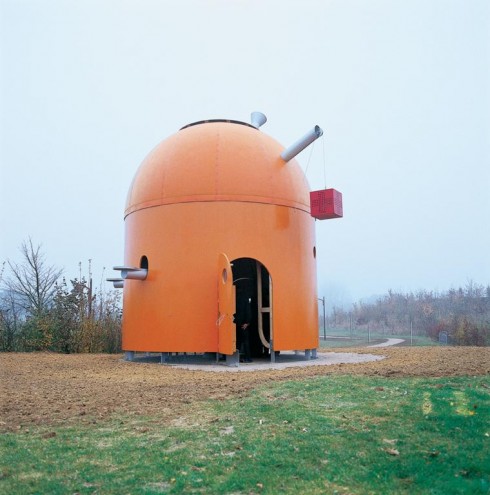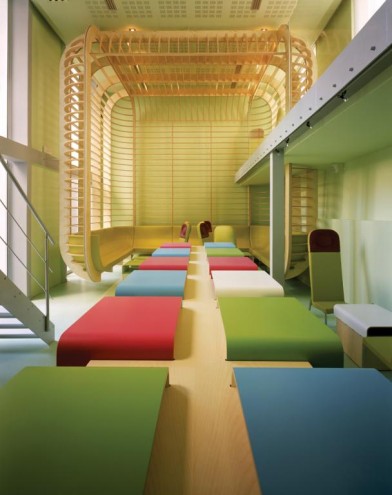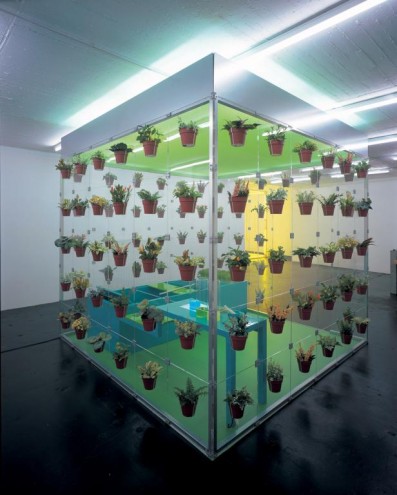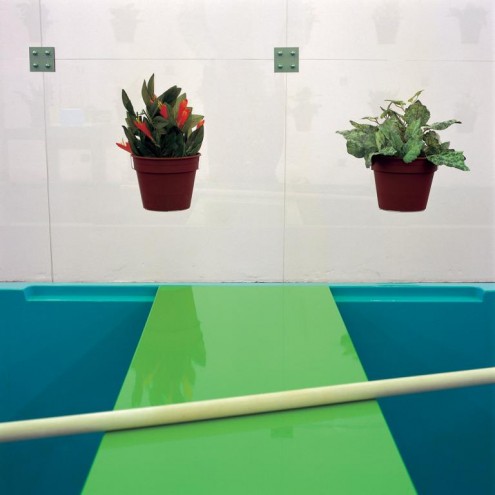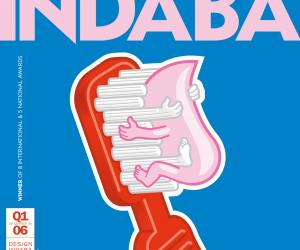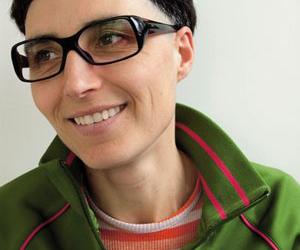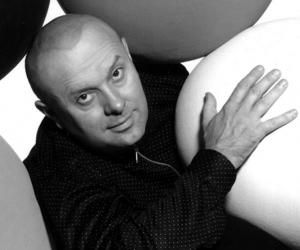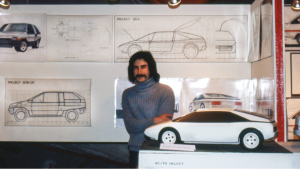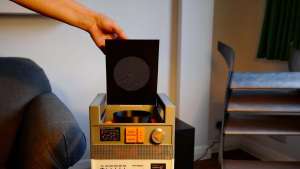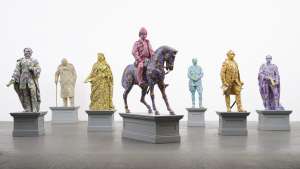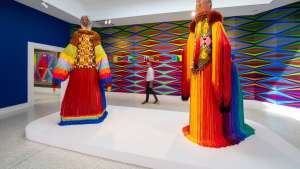First Published in
The Centre Georges Pompidou in Paris, the Museo DO Design in Lisbon, the Museum of Modern Art in New York... these are just a few of the public institutions that own works by Matali Crasset. In a relatively short career spanning a mere 14 years, the designer born in Châlons-en-Champagne has been quick to reach European star status.
If she was once hailed as a promising student, she herself is now regularly invited to lecture at renowned design schools throughout France and in cities like Copenhagen, Milan, Lausanne and Amsterdam. As a recent graduate she showed at the Milan Triennial and from there was snapped up by Denis Santachiara in Milan, working on architectural and design projects.
Upon her return to Paris, she spent five years in Philippe Starck's studio and did a stint at Thomson Multimedia before setting up her own business in 1998. Thus far she's notched up several awards and even more clients, including Hermès, Edra and Artemide.
Curating museum and travelling exhibitions is also a specialty of hers. Since 1998 she has been involved in creating the look-and-feel of various salons at European design expos, such as Who's Next, Première Classe and Première Vision in Paris, and the "Extra Trend Show" at the Tendence fair in Frankfurt. She'll be in charge of the next St-Etienne Biennale.
An asset to the design world, Ms Crasset will be traveling to the ninth International Design Indaba Conference as a speaker. To accompany the essay on her work by Marc Augé, we asked her to describe her work in her own words.
Domesticity seems to be an important part of your work. In 1998 you developed a range of designs for objects and furniture that focused on domestic rituals. One of your very first projects, The Domestic Trilogy was presented at the Milan triennial in 1991. This consisted of three diffusors, which spread water, warmth and light. What was the thinking behind this? What did these three aspects represent?
The Domestic Trilogy was my graduation project at Les Ateliers. It's about the domestication of technology through an enquiry into light, heat and water. We need to forget all our preconceived notions about technology in order to make it visible and comprehensive. We have lost touch with the sensation of the natural elements. The elements have become immaterial and humans have lost a sense of their origins. There's electrical heating in our floors, the air is conditioned… so I decided to work more closely with the elements and proposed these three diffusors. Thanks to this project, I met Denis Santachiara and was able to work with him.
With its domestic slant, a lot of your work tends to focus on the softer side of life and this is echoed in your use of soft textured materials - felt, in particular. Do you agree with this assessment?
I don't have any inclination for any material. I don't think in terms of materials or colours… I am more interested in modular, mobile furniture than in status objects. I first think about the project then I adapt it to the context.
Apart from designing the interiors of homes, clothing shops and restaurants, you've also done some jobs that are hardly run-of-the-mill commissions. Like that pigeon loft in Caudry, which was part of the programme "Nouveaux Commanditaires" for the Fondation de France. Speaking of beauty and the beast, you've also done the interior for Tout'ouvert, a pet grooming parlour in Nice. With humans, it is a lot easier to adopt a user-centred design approach, where you can assess and respond to the user's needs, than it is with animals. But what of the way in which dogs would relate to the premises? Was there any of this kind of thinking in your approach to the parlour? Or was the job more about the aesthetic appeal for humans?
Tout'ouvert is a pet grooming parlour as well as the place where the owner lives. When Carole Heleine, the owner, visited the HI hotel [Matali did the interior], it was a shock for her but at the same time a revelation. She was not so interested in contemporary design but she decided, after her visit to the hotel, to change her way of living, to sell her flat, and to work in the place where she lives. It's like a fairy tale in a certain way. It means that interior architecture can be engaging. So I agreed to work with her on this project because I like this kind of metamorphosis and I like to help people to feel and be well in our times. The result is an open-plan place, a mini-loft with two beds within 40 square metres.
You've created a piece of "urban" furniture known as The Empathetic Chair. What makes a piece "urban", or "empathetic" for that matter?
The Empathic Chair was developed as part of a research project for the Sandberg Institute of Amsterdam. It's a chair for the street. Cars reign over cities. The Arc de Triomphe square has come to remind us more of a huge traffic intersection than a symbol of Paris. Little by little, the streets are taken over by economic interests. Cities and streets must be given back to the citizens. The Empathic Chair is a welcoming structure that shows that cities are made of sensitive materials. It is actually a set of street furniture consisting of a chair and eight attachable extensions, allowing you to live, experiment and discover a new way to view the city.
Seven years into an already established career, the French government awarded you a scholarship to pursue your "Autogenous Design" project. What is autogenous design? Can you give us some examples of the object or products that were produced as a result of this project?
My autogenous lamp is a research project. It's a one-off piece. It's a reflection on energy. "What if objects were autonomous and were able to produce their own energy? What if they, at last, became autarchic?" In my design for the autogeneous lamp, there is only the lampshade left: the only element retained is the symbol of the lamp. But can the memory of the original object suffice? One has to draw on existing forms in order to rethink them. The new form of the lamp represents a memory of a previous use that has been diverted by another intention. From a symbolic point of view, a lamp represents a point of transition, a place where energy is consumed and transformed into something else - light. The lamp is switched on by turning the lampshade upside down. In this way, the on/off switch is rematerialised by a gesture or action, and the form remains respectful of its use.
What is your design philosophy? How would you categorise your output?
I don't want to change anything, only propose things to those who are interested. I think more in local terms than in global ones.
Read Marc Augé's essay on Matali Crasset's work.
The Centre Georges Pompidou in Paris, the Museo DO Design in Lisbon, the Museum of Modern Art in New York... these are just a few of the public institutions that own works by Matali Crasset. In a relatively short career spanning a mere 14 years, the designer born in Châlons-en-Champagne has been quick to reach European star status.
If she was once hailed as a promising student, she herself is now regularly invited to lecture at renowned design schools throughout France and in cities like Copenhagen, Milan, Lausanne and Amsterdam. As a recent graduate she showed at the Milan Triennial and from there was snapped up by Denis Santachiara in Milan, working on architectural and design projects.
Upon her return to Paris, she spent five years in Philippe Starck's studio and did a stint at Thomson Multimedia before setting up her own business in 1998. Thus far she's notched up several awards and even more clients, including Hermès, Edra and Artemide.
Curating museum and travelling exhibitions is also a specialty of hers. Since 1998 she has been involved in creating the look-and-feel of various salons at European design expos, such as Who's Next, Première Classe and Première Vision in Paris, and the "Extra Trend Show" at the Tendence fair in Frankfurt. She'll be in charge of the next St-Etienne Biennale.
An asset to the design world, Ms Crasset will be traveling to the ninth International Design Indaba Conference as a speaker. To accompany the essay on her work by Marc Augé, we asked her to describe her work in her own words.
Domesticity seems to be an important part of your work. In 1998 you developed a range of designs for objects and furniture that focused on domestic rituals. One of your very first projects, The Domestic Trilogy was presented at the Milan triennial in 1991. This consisted of three diffusors, which spread water, warmth and light. What was the thinking behind this? What did these three aspects represent?
The Domestic Trilogy was my graduation project at Les Ateliers. It's about the domestication of technology through an enquiry into light, heat and water. We need to forget all our preconceived notions about technology in order to make it visible and comprehensive. We have lost touch with the sensation of the natural elements. The elements have become immaterial and humans have lost a sense of their origins. There's electrical heating in our floors, the air is conditioned… so I decided to work more closely with the elements and proposed these three diffusors. Thanks to this project, I met Denis Santachiara and was able to work with him.
With its domestic slant, a lot of your work tends to focus on the softer side of life and this is echoed in your use of soft textured materials - felt, in particular. Do you agree with this assessment?
I don't have any inclination for any material. I don't think in terms of materials or colours… I am more interested in modular, mobile furniture than in status objects. I first think about the project then I adapt it to the context.
Apart from designing the interiors of homes, clothing shops and restaurants, you've also done some jobs that are hardly run-of-the-mill commissions. Like that pigeon loft in Caudry, which was part of the programme "Nouveaux Commanditaires" for the Fondation de France. Speaking of beauty and the beast, you've also done the interior for Tout'ouvert, a pet grooming parlour in Nice. With humans, it is a lot easier to adopt a user-centred design approach, where you can assess and respond to the user's needs, than it is with animals. But what of the way in which dogs would relate to the premises? Was there any of this kind of thinking in your approach to the parlour? Or was the job more about the aesthetic appeal for humans?
Tout'ouvert is a pet grooming parlour as well as the place where the owner lives. When Carole Heleine, the owner, visited the HI hotel [Matali did the interior], it was a shock for her but at the same time a revelation. She was not so interested in contemporary design but she decided, after her visit to the hotel, to change her way of living, to sell her flat, and to work in the place where she lives. It's like a fairy tale in a certain way. It means that interior architecture can be engaging. So I agreed to work with her on this project because I like this kind of metamorphosis and I like to help people to feel and be well in our times. The result is an open-plan place, a mini-loft with two beds within 40 square metres.
You've created a piece of "urban" furniture known as The Empathetic Chair. What makes a piece "urban", or "empathetic" for that matter?
The Empathic Chair was developed as part of a research project for the Sandberg Institute of Amsterdam. It's a chair for the street. Cars reign over cities. The Arc de Triomphe square has come to remind us more of a huge traffic intersection than a symbol of Paris. Little by little, the streets are taken over by economic interests. Cities and streets must be given back to the citizens. The Empathic Chair is a welcoming structure that shows that cities are made of sensitive materials. It is actually a set of street furniture consisting of a chair and eight attachable extensions, allowing you to live, experiment and discover a new way to view the city.
Seven years into an already established career, the French government awarded you a scholarship to pursue your "Autogenous Design" project. What is autogenous design? Can you give us some examples of the object or products that were produced as a result of this project?
My autogenous lamp is a research project. It's a one-off piece. It's a reflection on energy. "What if objects were autonomous and were able to produce their own energy? What if they, at last, became autarchic?" In my design for the autogeneous lamp, there is only the lampshade left: the only element retained is the symbol of the lamp. But can the memory of the original object suffice? One has to draw on existing forms in order to rethink them. The new form of the lamp represents a memory of a previous use that has been diverted by another intention. From a symbolic point of view, a lamp represents a point of transition, a place where energy is consumed and transformed into something else - light. The lamp is switched on by turning the lampshade upside down. In this way, the on/off switch is rematerialised by a gesture or action, and the form remains respectful of its use.
What is your design philosophy? How would you categorise your output?
I don't want to change anything, only propose things to those who are interested. I think more in local terms than in global ones.

